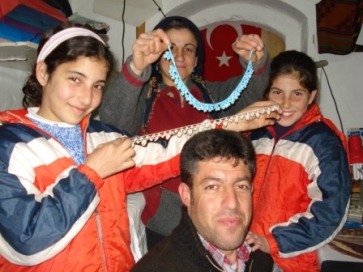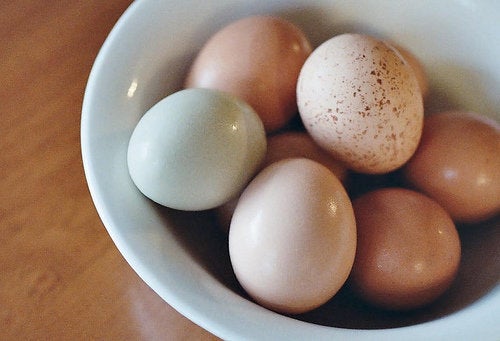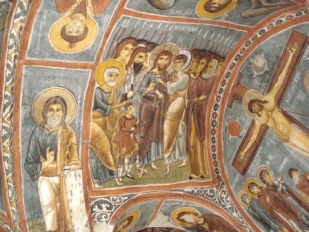Even if one is not religious, it is one of the nicest places to spend Easter: Cappadocia, Turkey, the home of the fairy chimneys -- these huge lunar pillars, cones, and spires rising in a crisp blue-white sky -- with the churches of the earliest Christian monks carved in their caves. The strange landscape (made of compressed volcanic ash) goes on for miles, and I chose the village of Goreme as my base, as it is known for its "open air museum.
The oldest chapel of this museum -- a UNESCO World Heritage Site -- is dedicated to St. Basil, the man who started the whole tradition of monasteries. Stepping over the open graves of the former monks (shaped like oblong bodies), one enters a rounded enclosure with bright frescos of what are called "Maltese crosses" (painted in red ochre) as well as frescos of Jesus Christ and George spearing a tail-less dragon. The monks used to pray in these caves and then go to the villages to teach the Christians in their homes (when not persecuted by the Romans).
The most spectacular cave churches at the site -- such as the "Dark" Chapel and St. Barbara's Chapel -- are covered in vivid frescos depicting early Jesus at the last supper, Judah giving him a kiss or -- a popular image -- Lazarus rising from the dead.
My favorite: the church dedicated to St. Katherine, whom I learned is considered the "intellectual" saint. It was "Anna," the richest most powerful woman in Byzantine who funded this chapel. "One strong woman gives homage to another," my learned guide Mustafa explained, as he smiled under the arch.
The refectory where the monks ate was also of interest: in the stone is carved a vat for the monks to stamp grapes -- for the wine to run out a small hole into a puddle. Even today, Cappadocia wine -- deeply fruited and lightly oaked -- is an exquisite treat. Eager to see the sun set over the valley -- with only ten minutes to go before the day had gone -- I hitched a ride with a young man on a motorbike, who told me -- as we clumped up the hills -- that he liked to keep his moped unrepaired as the clip-clopping sound reminded him of the sound the horses made when his grandfather took him around on a cart. He also told me that as a child, he was told that fairies hid in the odd pillars, and he had been afraid. Now he knew it was a myth, he said. After the sun set into darkness, the young man scooted me over to the town hammam, where I stripped in a room of stone while a woman (in a rather bad mood) scrubbed me in a frenzy of suds.
Her two daughters eagerly came forward. "A necklace!" I said -- touching my bare neck. "Yes," she said. She was a maker of necklaces. Each took three days to make. The husband poured me a cup of tea, while the woman and her daughters hooked and unhooked necklace after necklace around my neck -- the man inspired to take pictures -- and even a video -- of each intricate lace design on my skin, and the girls exclaiming in particular over one that was a turquoise blue. "You know, I lost my necklace!" I said, thinking of Lazarus rising from the dead.
"And this is yours," the woman said, as we listened to the music of Asik Veysel, chanting about love and life.
When we parted, she gave me a kiss on both cheeks and a strong hug at the door, she in her veil, me in my blue.

Support HuffPost
Our 2024 Coverage Needs You
Your Loyalty Means The World To Us
At HuffPost, we believe that everyone needs high-quality journalism, but we understand that not everyone can afford to pay for expensive news subscriptions. That is why we are committed to providing deeply reported, carefully fact-checked news that is freely accessible to everyone.
Whether you come to HuffPost for updates on the 2024 presidential race, hard-hitting investigations into critical issues facing our country today, or trending stories that make you laugh, we appreciate you. The truth is, news costs money to produce, and we are proud that we have never put our stories behind an expensive paywall.
Would you join us to help keep our stories free for all? Your contribution of as little as $2 will go a long way.
Can't afford to donate? Support HuffPost by creating a free account and log in while you read.
As Americans head to the polls in 2024, the very future of our country is at stake. At HuffPost, we believe that a free press is critical to creating well-informed voters. That's why our journalism is free for everyone, even though other newsrooms retreat behind expensive paywalls.
Our journalists will continue to cover the twists and turns during this historic presidential election. With your help, we'll bring you hard-hitting investigations, well-researched analysis and timely takes you can't find elsewhere. Reporting in this current political climate is a responsibility we do not take lightly, and we thank you for your support.
Contribute as little as $2 to keep our news free for all.
Can't afford to donate? Support HuffPost by creating a free account and log in while you read.
Dear HuffPost Reader
Thank you for your past contribution to HuffPost. We are sincerely grateful for readers like you who help us ensure that we can keep our journalism free for everyone.
The stakes are high this year, and our 2024 coverage could use continued support. Would you consider becoming a regular HuffPost contributor?
Dear HuffPost Reader
Thank you for your past contribution to HuffPost. We are sincerely grateful for readers like you who help us ensure that we can keep our journalism free for everyone.
The stakes are high this year, and our 2024 coverage could use continued support. If circumstances have changed since you last contributed, we hope you’ll consider contributing to HuffPost once more.
Already contributed? Log in to hide these messages.



